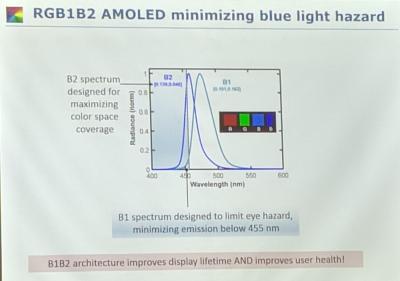In 2010 Universal Display announced a new AMOLED display architecture called RGB1B2 that uses two blue sub-pixels - a fluorescent deep-blue and a phosphorescent light blue. The introduction of a light blue sub-pixel can significantly extend the operational lifetime of an OLED display and reduce the display's power consumption by as much as 33%.

The RGB1B2 was never adopted (one of the reasons is that adding another sub pixel complicates the TFT backplane and has other disadvantages - but the architecture is now again on the table and UDC presented it again at OLED Korea 2019.
It turns out that in addition to the significant power savings, the RGB1B2 also mimizies the blue light emission of the OLED display. Excessive exposure to blue light has been linked to many health issues - including cancer, diabetes, heart disease, obesity and insomnia. There has been a lot of discussion on eye-safely and eye-comfort lately, with OLEDs seen as better displays than LCDs in this regard. UDC's architecture could enable, perhaps, even safer displays for our mobile devices.
Comments
That's a good question Joe, I don't have a good answer though...
The easy answer is that UDC didn't update any solid progress on blue for nearly 9 years. So it brings this RGB1B2 to fool investors. The same is to the narrow red emitters they will show in this Display Week.
Exactly - looking at the spectra in the article the light blue is likely the same phenylimidazole emitters that gave them their light blue breakthrough around 10 years ago. Since then we've had the imidazophenanthrolines, carbenes (BASF IP) and platinum macrocycles (Fuji IP) and still nothing that will move phos blue on to the market. One of the big selling points of RGB1B2 first time around was that the deep blue was needed less so you could get away with a lower lifetime material and even now they need to use a fluorescent deep blue.


Ron - what is the reason it is back on the table, if it wasn't viable before?